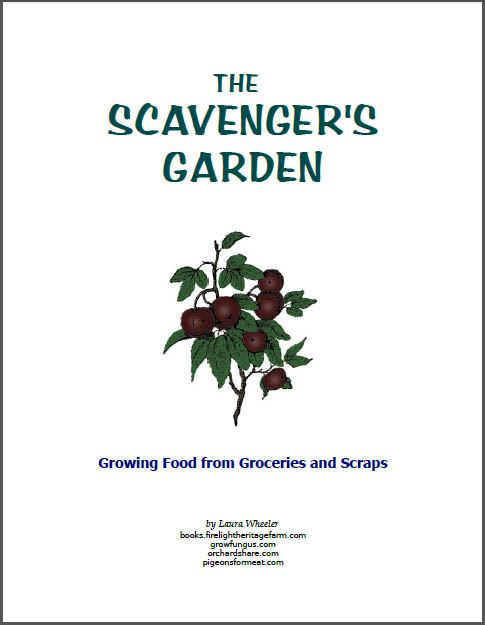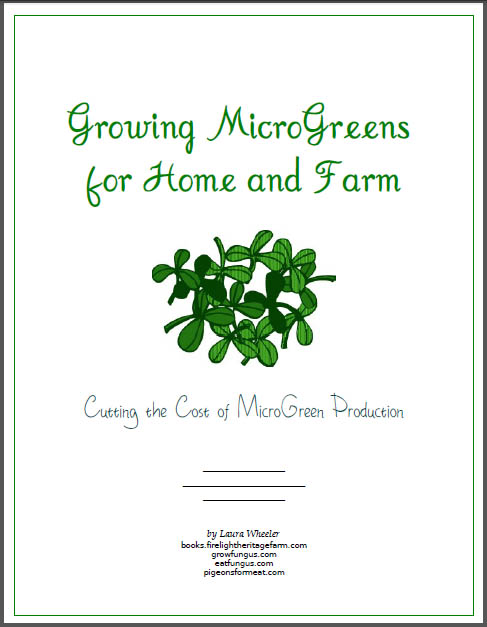 Click to Download Your Free Heritage Pickling and Culturing e-Book Now!
Click to Download Your Free Heritage Pickling and Culturing e-Book Now!
Instant Download, NO Registration Required!
Back to Eden Garden Mulches - More than Just Woodchips!
Woodchip gardens really work. Deep mulch no-till is another name for them. Our own experience with them both in the ground, and in containers, has proven that a deep mulch is very helpful in encouraging growth, and in saving water. A deep mulch garden is also suitable for cultivating mushrooms throughout the garden (many kinds work for this, including Wine Cap, Elm Oyster, Phoenix Oyster, Wood Blewit or Field Blewit, Parasols, etc).
The savings in water is so remarkable that even in black plastic containers in the middle of a southern summer, the containers only required watering every third day (as opposed to EVERY day in containers without mulch). In fact, as little as an inch of mulch was enough to realize that benefit.
The Back to Eden Film recommends wood mulch, but gardeners across the US have used many kinds of mulches which have proven effective. Each type kind of has its own pros and cons, and there is a general rule for adding mulch.
The basic guidelines that we have developed in using deep mulch no-till gardening methods is as follows:
1. When building your mulch layers to begin with, finer mulches go on on the bottom. Medium grade mulches go on top of that, and coarse mulch on that. The Back to Eden gardening magic works because coarse woodchips break down, and end up with fine composted wood on the bottom, partially broken down stuff in the middle, and coarser undigested stuff on the top. When you put finer (smaller pieces) mulches on the bottom and layer coarser stuff on top, then the finer stuff breaks down faster than the coarser stuff, and you can jumpstart the process in this way. You may also layer on fine mulch one year, medium grade the next year, and coarse stuff after that to jumpstart the composting process.
2. Manures are scattered on the top, where they leach in with watering or rain. Manures only need to be applied once per year once things get going, though you might want to do so twice the first year for heavy feeders.
3. At least 1" of mulch is needed to get good coverage. Even that much will work the miracle of water saving, and start building compost.
4. Mulch color can help mitigate climate conditions. Dark mulches draw heat - Alaskans, and people living in northern states can use dark colored mulches to warm the soil more. Light colored mulches help cool the soil. Southern gardeners can use light woodchips or shavings on the top layer to reflect some of the heat back off the soil and keep the ground temps a little lower. This can really help in conserving water, and in helping the gardens last longer in the intense heat.
5. You can use pretty much ANY organic matter, though coarseness and degradability vary between mulch types, and some kinds have peculiar problems that you need to compensate for.
So what are some of the mulches you can use, and what are the potential benefits or problems they can cause?
- Coarse Woodchips - These work well for an all purpose garden mulch. The down side is that they degrade slowly, so it can take several years to get the best benefits from your garden. They are great long term, or on top of finer layers to begin with, but probably NOT the best thing to start with.
- Wood Shavings - Medium sized wood pieces degrade more quickly than coarse woodchips. We often start using these if we do not have access to multiple sizes of wood mulch. They will compost within a few months, so by the time your plants are feeding heavily the shavings are already composting into nice black dirt.
- Sawdust - Fine wood particles degrade very fast, and can be used to jumpstart a no-till garden. Used as a bottom layer, they will decompose within a month or two. If this is all you have, you will need to re-apply them at least once during the growing season. Sawdust is also terrific for potato beds, especially where wireworms are a problem.
- Straw - Straw composts down nicely in garden beds. It is harder to work with due to the long strands that don't push aside as easily, and which are more difficult to add among existing plants. It is readily available, and fairly cheap. It WILL produce wheatgrass! Quite a lot of it. To prevent the grass, wet the straw bale daily for about two or three weeks, until wheatgrass begins to sprout. Then stop watering, and let it completely dry out to kill the grass. Use the straw once the grass is dead. This takes extra time, but will keep the wheatgrass from growing in your garden.
- Hay - Hay will compost faster than straw, and has the same kinds of pros and cons, with even more grassy weed problems. Use the same methods for compensating for the problems.
- Industrial Waste - Coir, Hulls, or other plant matter from industrial processing can be used for garden mulch, but make sure you know what chemicals it may have been exposed to during processing. It may be fine or coarse in texture, so use accordingly.
- Garden Waste - When using dead plant matter, it is best that it is dried and cut up prior to spreading over the surface of the garden. This makes it easier to work in your garden, and it makes it compost in place more evenly.
- Leaf Litter - Leaves are great mulch, but they have a couple of issues. They can get very slick when they are composting down, and they tend to decompose into a fairly sticky mud. Leaf litter may be best used in combination with wood shavings or wood chips, or even straw. If leaves are applied in the fall, they can decompose over the winter, and be ready to have a layer of wood or straw put on top of them in the spring.
- Needle Litter - If you have piles of conifer needles that need a home, they can be scattered on the garden. Usually you won't have enough to make a difference in mulch depth, and they really aren't that good at holding water or providing soil protection. They do help build the soil though, and can be useful in helping to acidify the soil when needed. Needles break down fairly slowly, and will work better if scattered around rather than left in concentrated clumps.
- Grass Clippings - DRIED grass clippings can be good mulch for your garden, provided it does not have weed seeds, or herbicides in it. In general, fresh grass clippings may be a better animal feed item than garden mulch - they may be fed fresh to rabbits, chickens, goats, cattle, pigs, ducks, geese, etc. The animals appreciate the weed seeds more than the garden does! Left in place on your lawn though, they are of more use to the lawn than they usually would be to your garden.
In summary, most dried plant matter makes good mulch in the garden, and with a little adaptation or compensation, you can make use of what you have, or what you can get cheaply.
If you are uncertain about using something on your garden, use it in one corner and see how it performs. That way, if it attracts unwelcome pests, or produces copious weeds, you won't be risking your entire garden.
A healthy no-till deep mulch garden can be achieved with the use of many kinds of mulches and organic debris. Mother Nature uses it all, so we might as well too!








